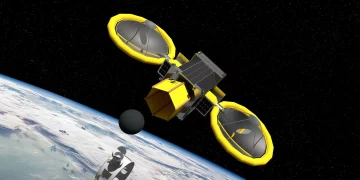Space tourism is no longer just a sci-fi fantasy. With advancements in space technology, the dream of civilians traveling to outer space is becoming a reality. Over the past few years, private companies like SpaceX, Blue Origin, and Virgin Galactic have made significant strides in making space travel accessible to the masses. As these companies continue to innovate and expand their operations, the future of space tourism looks increasingly promising.
This article delves into the rapidly growing space tourism industry, the technologies behind it, and what we can expect for the future of human space exploration as tourism ventures into the cosmos.
1. The Birth of Space Tourism
Space tourism as a concept began to take shape in the early 21st century. In 2001, Dennis Tito, an American entrepreneur, became the first private citizen to travel to space aboard Russia’s Soyuz spacecraft. This marked the first step toward a new era in which space would no longer be the exclusive domain of astronauts and government space agencies. However, the cost of this trip—approximately $20 million—meant that space travel was still a luxury only accessible to the ultra-wealthy.
The true boom in space tourism, however, began in the 2010s as private companies entered the race to build reusable spacecraft that could reduce the cost of space travel. Companies like Blue Origin, Virgin Galactic, and SpaceX have pushed the boundaries of what was previously thought possible, each taking a unique approach to space tourism.
2. Technologies Behind Space Tourism
The growing space tourism industry is driven by a combination of cutting-edge technologies, particularly in the areas of rocketry, spacecraft design, and reusability. These technologies are reducing the cost of travel, increasing safety, and opening up new possibilities for civilian space exploration.
1. Reusable Rockets
One of the major technological innovations in space tourism is the development of reusable rockets. Traditional space travel involved single-use rockets, which made space missions incredibly expensive. However, the advent of reusable rocket technology has significantly lowered costs, making space tourism more feasible.
- SpaceX, led by Elon Musk, has pioneered the development of Falcon 9 and Starship rockets, which can land back on Earth after launching into space and be reused for subsequent missions. This reusability is a game-changer in reducing the cost of space travel. SpaceX’s Starship is particularly exciting, as it is designed to carry passengers to destinations beyond Earth, including the Moon and Mars, in the future.
- Blue Origin, founded by Jeff Bezos, has also made strides with its New Shepard rocket. This suborbital vehicle is designed for short trips to the edge of space, allowing passengers to experience a few minutes of weightlessness and stunning views of Earth. Like SpaceX, Blue Origin is focused on reusability, with New Shepard’s booster and capsule returning to Earth after each flight.
2. Spacecraft Design and Comfort
While rockets are a critical component of space tourism, the spacecraft that carry tourists to space also play a vital role in ensuring comfort and safety. The design of these spacecraft is optimized to accommodate passengers on suborbital and orbital flights.
- Virgin Galactic uses a SpaceShipTwo vehicle, a suborbital spaceplane that is air-launched from a mothership. It provides passengers with a brief but exhilarating experience of weightlessness as they travel to an altitude of about 50 miles. Unlike traditional rockets, SpaceShipTwo’s design is more akin to an airplane, with comfortable seats and windows for a scenic view of space.
- SpaceX’s Crew Dragon capsule, initially developed for NASA’s crewed missions to the International Space Station (ISS), has been adapted for space tourism. The capsule is equipped with advanced life-support systems, touchscreen controls, and large windows, providing a more luxurious experience for private astronauts.
3. Spaceports
Space tourism also requires the establishment of specialized facilities known as spaceports. These are launch and landing sites designed to handle the complexities of commercial space travel, including the safe takeoff, flight, and landing of spacecraft.
- Virgin Galactic has already built its Spaceport America in New Mexico, which serves as its primary hub for space tourism launches. Spaceports like these are designed to accommodate frequent launches, ensuring the safe transportation of passengers to and from space.
- Blue Origin operates out of its Launch Site One in West Texas, where it conducts test flights and prepares for future commercial space tourism missions.

3. The Experience of Space Tourism
Space tourism offers a once-in-a-lifetime experience for individuals who have the opportunity to travel into space. However, this experience can vary depending on the company and the mission type.
1. Suborbital Space Tourism
Most space tourism companies, including Blue Origin and Virgin Galactic, focus on suborbital flights, where passengers are launched to the edge of space and experience a few minutes of weightlessness before descending back to Earth. These flights are relatively short, lasting anywhere from 10 to 90 minutes, but they offer an extraordinary experience of seeing the curvature of the Earth and the blackness of space.
- Blue Origin’s New Shepard rocket offers this experience by sending tourists just beyond the Kármán line—the internationally recognized boundary of space—at around 62 miles above Earth. Passengers aboard the spacecraft experience a few minutes of weightlessness, during which they can float freely and look out the large windows at the breathtaking views.
- Virgin Galactic’s SpaceShipTwo operates in a similar fashion, reaching altitudes of around 50 miles, giving passengers a few minutes of weightlessness before gliding back to Earth.
2. Orbital Space Tourism
While suborbital flights are currently the most accessible form of space tourism, orbital space travel—where passengers travel into low Earth orbit (LEO)—is the next frontier. This type of flight would involve a more extended mission and could involve staying aboard the International Space Station (ISS) or other space habitats for an extended period of time.
- SpaceX is leading the way in this area, with plans to offer orbital flights aboard its Crew Dragon spacecraft. SpaceX has already successfully launched astronauts to the ISS under NASA’s Commercial Crew Program, and the company’s future plans include sending private tourists into orbit. SpaceX’s Inspiration4 mission in 2021 marked a significant milestone, as it sent an all-civilian crew to orbit for a few days.
3. Space Hotels and Habitats
In the future, space tourists may have the opportunity to stay in space hotels or orbital habitats, turning space travel into a longer-term vacation experience. Companies like Axiom Space are already planning to build commercial space stations that will serve as hotels for private citizens. These stations could offer a unique way for people to experience life in space, with stunning views of Earth, microgravity experiences, and even spacewalks.
4. The Future of Space Tourism
While the space tourism industry has made incredible progress, the road ahead is filled with both excitement and challenges. Here’s a look at some of the future developments we can expect in the industry:
1. Lower Costs and Increased Accessibility
The cost of space tourism is currently extremely high, with tickets for suborbital flights priced at anywhere between $200,000 and $500,000. However, as the technology behind space travel continues to evolve, economies of scale and increased competition will likely drive prices down, making space tourism more accessible to a broader audience.
The development of reusable rockets and more efficient spacecraft is expected to lower the cost per flight, and as more companies enter the space tourism market, we may see prices dropping significantly over the next few decades. With lower costs, space tourism could eventually become as common as commercial air travel.
2. Space Exploration Beyond Earth Orbit
In the coming decades, space tourism could expand beyond low Earth orbit and into deeper space. SpaceX’s Starship is designed for missions to the Moon, Mars, and beyond, and it could play a crucial role in offering tourists a chance to venture into deep space. Future space tourists could participate in missions that take them to the Moon, perhaps for a lunar orbit or even to land on its surface. This type of space tourism would offer an unparalleled experience, allowing individuals to see the Earth from a completely new perspective.
3. New Frontiers in Space Exploration
As space tourism continues to evolve, we can expect new, innovative experiences for tourists. This could include spacewalks, trips around the Moon, and even the chance to experience the zero-gravity environment of deep space for extended periods. Companies will likely begin to experiment with creating specialized destinations, such as floating space hotels or private lunar bases, to provide tourists with more extended stays.
5. Conclusion
The future of space tourism is incredibly bright, with major companies leading the charge in making space travel a reality for civilians. The rapid advancements in rocket technology, spacecraft design, and reusability are driving down costs and opening up new opportunities for space tourists. As the industry continues to mature, we can expect to see space travel become more accessible, with increasingly diverse experiences that could take us to the Moon, Mars, and beyond.
The next step for space tourism could well be a future where space is no longer just a distant frontier, but a destination for those who dare to dream beyond our planet.


















































Discussion about this post